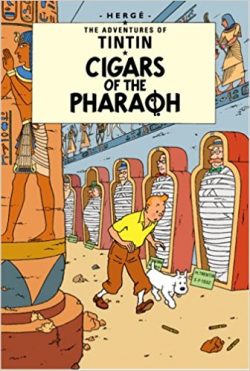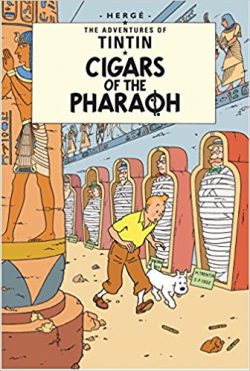

By Hergé & various; translated by Leslie Lonsdale-Cooper & Michael Turner (Egmont)
ISBN: 978-1-40520-803-1 (HB)Â Â Â Â Â Â Â Â Â Â Â Â Â Â Â Â Â Â Â : 978-1-40520-615-0 (PB)
By the time Georges Remi began Tintin‘s fourth serialised adventure – in weekly instalments in Le Petit Vingtiéme from December 1932 to February 1934 and gathered in a collected volume by Casterman in 1934 – he was well on the way to mastery of his art but was still growing as a writer.
Although the periodical format meant that a certain degree of slapstick and seemingly directionless action was necessary to keep the attention of the reader, Remi (known the world over as Hergé) was evolving by leaps and bounds, mastering the ability to integrate these set-piece elements into the building of a complete narrative.
Cigars of the Pharaoh is stylistically much more of a fully-realised and craftily-designed thriller, with a solid plot underpinning all the episodic hi-jinks.
Following directly on from Tintin in America, here the valiant boy reporter is returning from Chicago on an oceangoing liner headed to Egypt. Here he and Snowy meet Sophocles Sarcophagus – the first in a string of absent-minded professors which would ultimately culminate in the outlandishly irascible yet lovable Cuthbert Calculus.
Dithering archaeologist Sarcophagus has divined an ancient mystery that is somehow connected to a ring of ruthless drug smugglers. Tintin memorably encounters bumbling detectives Thompson and Thomson at this juncture, when narcotics are planted in his cabin, and a complex drama riotously unfolds as the lad and Sarcophagus discover a lost pyramid is not only the smuggler’s base but the foundation for a much darker game – the overthrow of nations!
Hergé introduced many other recurring and supporting characters in this tale. As well as the shambling policemen, there is the villainous seaman Captain Allan, globe-girdling small-trader Oliveira da Figueira and oily movie mogul Roberto Rastapopoulos, who would all figure strongly in later stories.
The author was gearing up for the long creative haul, and thus began inserting plot-seeds that would only flower in future projects…
When Tintin’s relentless investigations take him to India, where the villains are attempting to topple a Maharajah trying to destroy the Opium poppy industry, the plucky lad befriends the potentate and thwarts the plan of a crazed Fakir. This villain frequently employs a drug called Rajaijah, which permanently drives men mad, and is also somehow connected to the Egyptian gang.
The contemporary version of this tale was revised by Hergé in 1955, and sharp-eyed fans will spot a few apparent anachronisms, but the more open-minded will be able to unashamedly wallow in a timeless comedy-thriller of exotic intrigue and breakneck action.
Although the mystery of the Cigars of the Pharaoh ends satisfactorily with a climactic duel in the rugged and picturesque hill-country, the threat and relevance of Rajaijah would not be resolved until Hergé’s next tale, and his first masterpiece…
It’s hard to imagine that comics as marvellous as these still haven’t found their way onto everybody’s bookshelf, but if you are one of this underprivileged underclass, this lush series of hardback collections is a very satisfying way of rectifying that sorry situation. So why haven’t you..?
The Cigars of the Pharaoh: artwork © 1955, 1983 Editions Casterman, Paris & Tournai. Text © 1971 Egmont UK Limited. All Rights Reserved.
